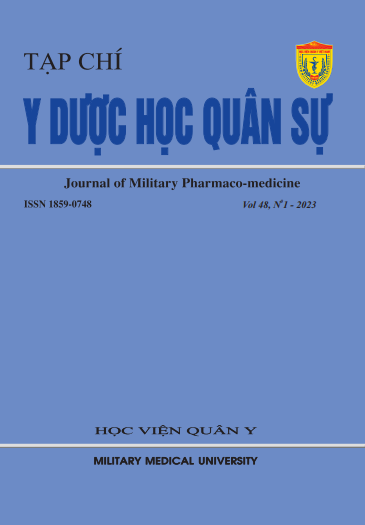DETERMINATION OF THE CHEMICAL COMPOSITION AND BIOACTIVITY OF THAN PHUC ((HOMALOMENA VIETNAMENSIS J. BOGNER ET V.D.NGUYEN), FAMILY (ARACEAE))
Main Article Content
Abstract
Objectives: To determine the chemical composition and biological activity of Than Phuc (Homalomena vietnamensis J. Bogner et V.D.Nguyen), family (Araceae)). Subjects and methods: The rhizomes of Than Phuc are collected in Dong Giang-Quang Nam. Preliminary determination of the composition by chemical reactions; Extraction of essential oils by steam distillation method, composition determination, and quantification by gas chromatography-mass spectrometry (GC/MS). The antimicrobial activity of the test is assessed through the turbidity of the culture medium. The antioxidant activity is investigated by DPPH free radical scavenging method. Results: Than phuc rhizomes have much essential oil, triterpenoids, tannins, and reducing agent. The main components of Than phuc essential oil are β-Linalool (71,19%), α-cadinol (8,10%), terpinen-4-ol (4.80%), tau-muurolol (4.89%). IC50 value for E.coli strain (2.51 ± 0.37 mg/mL), B.subtilis (2.87 ± 0.09 mg/mL), L.fermentum (3.33 ± 0.05 mg/mL), S.aureus (3.73 ± 0.04 mg/mL), C.albican (3.42 ± 0.05 mg/mL), P.aeruginosa (6.30 ± 0.17 mg/mL), S.enterica (3.56 ± 0.26 mg/mL). MIC at a dilution concentration of 5.65 mg/mL was able to inhibit 99% E.coli, 97% C.albican, 94% B.subtili, L.fermentum, and 88% S.aureus and at a dilution concentration of 22.58 mg/mL it has the ability to inhibit 100% S.enterica. The highest MBC values are for C.albican 97% and Gram (-) E.coli 99% at a dilution of 5.65 mg/mL. At a dilution concentration of 90.30 mg/mL, Than phuc essential oil inhibits 100% S.enterica and 99% S.aureus. EC50 value 58.05 ± 3.1 mg/mL. Conclusion: The main chemical composition of Than phuc is essential oil, in which monoterpenes without oxygen account for 4.43%, monoterpenes with oxygen account for 76.88%, sesquiterpenes make up 17.17%; essential oil has inhibitory effects (S.aureus, B.subtilis, L.fermentum, P.aeruginosa), bactericidal (E.coli and C.albican fungi) and has very weak antioxidant effects.
Article Details
Keywords
Than phuc, Homalomena vietnamensis, Biological activity, Antimicrobial, Antioxidant
References
2. Lê Thị Hương, Đào Thị Minh Châu, Nguyễn Viết Hùng, Nguyễn Công Trường, Đỗ Ngọc Đài (2017). Thành phần hóa học tinh dầu loài Thiên niên kiện (Homalomena occulta (Lour.) Schott) và Thần phục (Homalomena pierreana Engl.) ở vườn quốc gia Pù mát, Nghệ An. Hội nghị Khoa học toàn quốc về sinh thái và tài nguyên sinh vật lần thứ 7: 1236-1241.
3. Nguyễn Tập (2006). Điều tra cây thuốc và nghiên cứu bảo tồn. Nhiều tác giả: Nghiên cứu thuốc từ thảo dược. Nhà xuất bản KH&KT, Hà Nội: 33-109.
4. Brand-Williams, Wendy, Marie-Elisabeth Cuvelier, and C. L. W. T. Berset (1995). Use of a free radical method to evaluate antioxidant activity. LWT-Food Science and Technology; 28(1): 25-30.
5. Policegoudra, R. S., et al. (2012). Bioactive constituents of Homalomena aromatica essential oil and its antifungal activity against dermatophytes and yeasts. Journal de Mycologie Médicale; 22(1): 83-87.
6. Singh, Gurdip, et al. (2000). Studies on essential oils, part 28: Chemical composition, antifungal and insecticidal activities of rhizome volatile oil of Homalomena aromatica Schott. Flavour and Fragrance Journal; 15(4): 278-280.
7. Van, H. T., Nguyen, Q. P., Tran, G. B., & Huynh, N. T. A. (2021). Chemical composition and antibacterial activities of Homalomena vietnamensis bogner & v.d nguyen (Araceae). Journal of Microbiology, Biotechnology and Food Sciences: 201-204.
8. V.S, Rana, et al. (2010). Essential oil composition of Homalomena aromatica roots. Essential Oil Asoicitaion of India Delhi: 43-45.
9. Zeng L. B., Zhang Z. R., Luo Z. H., Zhu J. X., (2010). Antioxidant activity and chemical constituents of essential oil and extracts of rhizome Homalomena, Food Chem; 125: 456-463.


